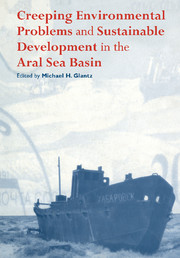Book contents
- Frontmatter
- Contents
- List of contributors
- Introduction
- 1 Sustainable development and creeping environmental problems in the Aral Sea region
- 2 Ecological disaster linked to landscape composition changes in the Aral Sea basin
- 3 Alteration of water level and salinity of the Aral Sea
- 4 Desertification in the Aral Sea region
- 5 Climate fluctuations and change in the Aral Sea basin within the last 50 years
- 6 Priaralye ecosystems and creeping environmental changes in the Aral Sea
- 7 Public health in the Aral Sea coastal region and the dynamics of changes in the ecological situation
- 8 The impact of political ideology on creeping environmental changes in the Aral Sea basin
- 9 Change of the rivers' flow in the Aral Sea basin (in connection with the problem of quantitative assessment and consideration of environmental after-effects)
- 10 Fish population as an ecosystem component and economic object in the Aral Sea basin
- 11 Creeping environmental changes in the Karakum Canal's zone of impact
- 12 Environmental changes in the Uzbek part of the Aral Sea basin
- 13 Creeping changes in biological communities in the Aral Sea
- Index
10 - Fish population as an ecosystem component and economic object in the Aral Sea basin
Published online by Cambridge University Press: 19 October 2009
- Frontmatter
- Contents
- List of contributors
- Introduction
- 1 Sustainable development and creeping environmental problems in the Aral Sea region
- 2 Ecological disaster linked to landscape composition changes in the Aral Sea basin
- 3 Alteration of water level and salinity of the Aral Sea
- 4 Desertification in the Aral Sea region
- 5 Climate fluctuations and change in the Aral Sea basin within the last 50 years
- 6 Priaralye ecosystems and creeping environmental changes in the Aral Sea
- 7 Public health in the Aral Sea coastal region and the dynamics of changes in the ecological situation
- 8 The impact of political ideology on creeping environmental changes in the Aral Sea basin
- 9 Change of the rivers' flow in the Aral Sea basin (in connection with the problem of quantitative assessment and consideration of environmental after-effects)
- 10 Fish population as an ecosystem component and economic object in the Aral Sea basin
- 11 Creeping environmental changes in the Karakum Canal's zone of impact
- 12 Environmental changes in the Uzbek part of the Aral Sea basin
- 13 Creeping changes in biological communities in the Aral Sea
- Index
Summary
Encompassing an area over 2.3 million km2, the Aral Sea basin was one of the largest economic regions of the former USSR. In the early 1960s, a program of extensive development of irrigated farming was launched using water from the Amudarya and Syrdarya, the largest Central Asian rivers flowing into the Aral Sea. By the mid-1970s and early 1980s, the intense use of the downstream flow resulted in the drying out of the riverbed in different seasons at a distance of about two hundred meters from the sea. This distance increased steadily at a rate of about 1 meter per year. The irrigated area in the mid-1980s had reached 6.8 million ha compared with 2.9 million ha in 1959. In the former USSR, 95% of the raw cotton and 40% of the rice was produced there. However, these Soviet attempts to conquer nature in the Aral region were accompanied by adverse environmental impacts. Steadily accumulating adverse impacts and their eventual interactions resulted in an environmental crisis in the early 1980s that evolved into an environmental disaster a few years later. As a result, the situation in the Aral Sea ranks among the largest human-induced environmental disasters in the twentieth century, in terms of geographic scope and degree of severity.
Water resource problems in the Priaralye region (the region around the Aral Sea) are a result of the diminution of the natural water supply to the Amudarya and Syrdarya deltas and their vegetation. The reduced water supply generated soil degradation, solonchak (saline soils) development on the newly exposed dry seabed, and large-scale salt and dust transport to adjacent areas, which have destabilized terrestrial ecosystems.
- Type
- Chapter
- Information
- Publisher: Cambridge University PressPrint publication year: 1999
- 3
- Cited by



